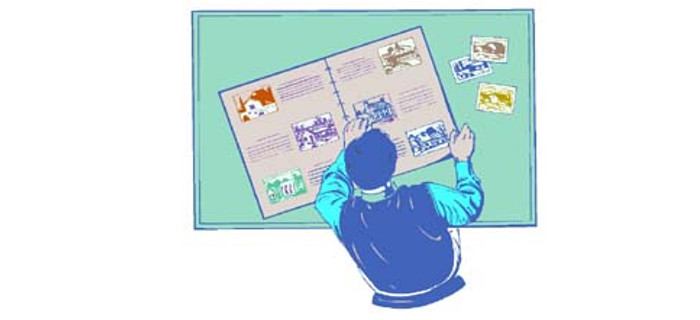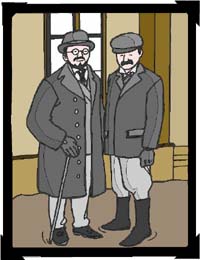Scrapbooking Your Family's History

Are you buried beneath a mountain of family photographs? Is your kitchen bookshelf teeming with recipe books inherited from grandmothers, great aunts and other long-dead ancestors? Do your children beg for bedtime stories detailing Uncle Manny's adventures as a crop duster pilot or Great Grandma Sylvia's days as a suffragette?
Genealogical research and scrapbooking are tremendously popular pastimes. Combining the two creates a lasting, archival record of the past to which every member of the family may contribute and enjoy for generations.
Why scrapbook?
Genealogists work with scads of documents--birth certificates, death notices, war records and many other sources essential to the family story. Each piece of information, whether documented orally or in writing, offers a unique and vital link to the past, but it often all ends up as just a dry pile of paper or disks. Even those genealogists who go on to write and publish family histories have often presented only the names and dates, with perhaps a story or two and a single photograph in accompaniment.
Family photographs have traditionally been mounted in albums using photo corners, glue, tape, and more recently, magnetic picture albums. Diaries and journals, if kept at all, have been personal and completely separate from the snapshots complementing the events and activities writ within. Scrapbooks were loosely bound clippings and memorabilia compiled with few explanations and fewer details and rarely included any photos.
These methods have many drawbacks. Practically speaking, photographs and newspaper clippings deteriorate rapidly when exposed to acids in paper, album pages and covers, and magnetic sheets. Memorabilia are also subject to the same hazards and may cause damage to photographs if mounted together. Pen writing used to identify pictures frequently results in their ruin when it bleeds over onto the face of the snapshot. Pencils mar photos by leaving indentations on the images.
But worse, the separation of family tales, family documents, family photographs, and oral tradition can leave the real story of your family lost in the details. Scrapbooking your family history solves all these dilemmas, by incorporating archival methods and materials with artist inspiration, family records and memorabilia, and participation by even the youngest members of a clan.
Scrapbooking basics
Scrapbooking is as individual a hobby as the person undertaking it. Memory books and pages may be simple or they may be complex, depending on you and your goals for your scrapbook. Scrapbooking supplies are archival quality; this means they are acid-free, do not contain PVC's (polyvinyl chloride), and will not harm photographs or keepsakes. The generations who follow will be able to enjoy and learn from these lovingly compiled pages.
Basic scrapbook pages consist of one or more photographs laid out on special paper, either plain or patterned, along with journaling done with acid-free pens or pencils. Stickers enhance the overall design, highlighting the theme or event portrayed on the page. Various sizes of albums and pages, including 8 1/2 x 11 and 12 x 12, enable scrappers to suit different albums and page formats to their distinct needs or purposes.
Advanced tools and techniques
If you really get into it, numerous options exist for more intricate and detailed memory albums. Die cuts--pre-cut paper shapes--come in a multitude of shapes, sizes and colors, as do stickers and other page accents. Templates constructed from heavy plastic allow scrapbook enthusiasts to trace and color design elements directly onto a page. Punch-outs are similar to dies cuts, incorporating multiple colors and patterns. Drawing and coloring tools run the spectrum of colors; available in varying tip thicknesses, these pens and pencils add vibrancy and variety to hand-drawn embellishments and journal entries.
Stamping and embossing are two methods creative memory album-makers can use to augment their page layouts even further. Stamps may be purchased in numerous motifs, and archival inks are produced in myriad colors--standard, fluorescent, and glitter-mixed. Some scrappers impress only stamp outlines then use pencils to fill in the details. Others use special stamping pens to colorize stamps before applying them to the scrapbook page.
Embossing raises an image from its background. Two techniques are used to achieve this effect. The first is embossing templates and tools. A light box is necessary when embossing with templates. Templates are placed directly upon the paper and the design marked into the paper from the back. An alternate method uses heat and embossing powder, fluid, or ink to apply the effect. In this manner, colored impressions may be raised from paper with the aid of an embossing heat tool.
Writing it down
Photographs and embellishments set the stage for the narrative history, written accounts of the events depicted and the people represented. Writing style varies with each individual; don't let lack of writing experience intimidate you. Guides written specifically for creators of memory albums offer tips and exercises intended as inspiration for less-than-confident scrapbookers.
There are several key questions to remember when preparing to journal: Who is in the photograph? What are they doing? What were they feeling? When was it? Where did it take place? Why is it important in the life of the individual, their family, or the family history?
 No matter which combinations of page elements are chosen, scrapbook pages worked with care and attention present an eye-pleasing effect, especially to those whose kin are represented in the finished product. Next time, we'll talk about specific types of family history scrapbook pages, as well as methods for gathering more information for memory album projects.
No matter which combinations of page elements are chosen, scrapbook pages worked with care and attention present an eye-pleasing effect, especially to those whose kin are represented in the finished product. Next time, we'll talk about specific types of family history scrapbook pages, as well as methods for gathering more information for memory album projects.
Deciding to chronicle a family's memoirs through scrapbooking is just the first step in an ongoing process. Each ancestor, family line, event and saga requires a choice about tools, techniques, page layouts and formats.
Genealogists who use memory albums and scrappers who incorporate their family histories into their scrapbooks have popularized several family history page types. Your album will reflect your style. These suggestions may be all you need. Or they can be a jumping-off point as you use your own approach.
Heritage pages
Heritage pages offer glimpses of the past, branches of the family tree upon which to rest and reflect upon where we are going and where we have been. Heritage layouts preserve family history through family photos and stories. They bring to life the eras during which our forefathers and mothers lived and loved, worked and played, laughed and cried.
Scrapbook papers, decorations, and ornaments have been designed to complement heirloom photographs and memorabilia. These supplies call to mind the time periods of our ancestors through colors and motifs. They're available at local stores, mail order, or Internet scrapbook or craft sites.
Frequently, those who create memory albums or scrapbooks limit their journal entries to the events in accompanying pictures. Chronicling of those kinfolk tales, tall and small, for which no snapshots exist is a vital task of family history keepers. When no photo is available, the journal entries in a scrapbook are more important.
When you plan a heritage layout, consider mounting snapshot reprints rather than originals. That way, if a mistake is made, there is no harm done to the antique photograph. Should a relative someday ask for a copy of the photo, the original is available for that purpose. Reproductions may be done quite economically: color or black and white photocopies; laser prints from a scanner; make-your-own-reprint machines, such as the Kodak Photo Maker; and of course, standard photo shop reprints.
The fun of hand-tinting is another reason to work with black and white reprints. It's a simple technique allowing touches of color to be added to black and white or sepia-toned photographs. This process transforms snapshots into focal points for heritage pages, and enhances traditional photos by softening sometimes severe poses. Special pens, pencils, and powders are available for handcoloring pictures. Some scrapbookers prefer to use archival oils and mix their own colors for altering photos.
Family tree, heirloom and recipe pages
Family tree layouts are another popular choice with family historians. Scrapbookers have devised innovative layouts for family trees. Some arrangements use merely pictures and names, some combine photos with brief biographical sketches, and still others may include individual anecdotes or journaling by living family members.
Family treasures and heirlooms contribute to the generational account of a family. Often these items carry with them tales of adventure, hard work, courage, joy, woe, or simply longevity. Clearly, it is impossible to mount these inheritances on a scrapbook page, even if you had them all. What then is the solution? Drawings and photographs of the items illustrate stories and legends. These heirloom pages provide detail otherwise left to the imagination, and can add to the importance of articles passed down through the ages.
Food nourishes the soul as well as the body. For many of us, memories center around the kitchen and companionable meals shared with family and friends. Recipe pages and albums extend the life of familial recipes by celebrating the creators, cooks, and memories associated with those recipes. Far more than simply a list of ingredients and instructions, recipe pages may incorporate snapshots, memoirs, and vivid recollections of shared experiences.
Legacy albums
The content of a legacy album may be identical to that of a heritage scrapbook, but its presentation focuses on longevity and preservation of family documents, history and memories. Decorative touches should be minimal in a legacy album as they distract from the main items and may fall apart over time. Photo sleeves or corners work best for mounting photos; avoid adhesives, as it is currently unclear how they may affect pages and snapshots in the future.
Remember not to crop your pictures for this album, as photographs hide clues to the people, times, and events that they represent in their backgrounds. Only museum quality materials are recommended for building a legacy album. Permanent binding on a legacy album helps ensure that this precious bequest will survive from one generation to the next.
With a little help from your friends (and relatives)
You may need help. Relatives might be able and willing to provide immeasurable assistance in compiling and composing the family's story. They can do this by identifying heirloom photographs, narrating vignettes, writing personal journal entries, filling in gaps in genealogical information, and sharing oral tradition about their forebears. These additions can turn a simple memory album into a family history scrapbook steeped in ancestral lore. What incentive for loving care throughout the decades and centuries to come.
Remember to return the favor when imposing on kin to participate in the project. This is especially important when borrowing genealogical documents or antique photos. You can pay for photocopying, postage and/or reprints. Of course you'd swap information which the person may need. You can explain why the scrapbook is significant and the value it has for the family, and present the individual with duplicate pages for their own memory book.
You may use all or only some of the family history approaches in your album. No matter, as references to your family's history round out scrapbooks and increase the future enjoyment they will bring.
Alessia Cowee is a contributing editor at ePregnancy.com, as well as at Suite 101. She mothers three children in Chico, CA.
